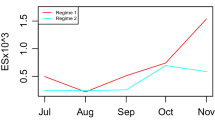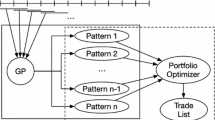Abstract
Recent years have seen a growing interest among investors in the new technology of blockchain and cryptocurrencies and some early investors in this new type of digital assets have made significant gains. The heuristic algorithm, differential evolution, has been advocated as a powerful tool in portfolio optimization. We propose in this study two new approaches derived from the traditional differential evolution (DE) method: the GARCH-differential evolution (GARCH-DE) and the GARCH-differential evolution t-copula (GARCH-DE-t-copula). We then contrast these two models with DE (benchmark) in single and multi-period optimizations on a portfolio consisting of five cryptoassets under the coherent risk measure CVaR constraint. Our analysis shows that the GARCH-DE-t-copula outperforms the DE and GARCH-DE approaches in both single- and multi-period frameworks. For these notoriously volatile assets, the GARCH-DE-t-copula has shown risk-control ability, hereby confirming the ability of t-copula to capture the dependence structure in the fat tail.



Similar content being viewed by others
Notes
Pearson’s correlation coefficients provide the degree of linear relationship between two variables.
Kendall is a nonparametric test that measures the strength of dependence between two variables. It is given by: \(\tau =\frac{n_c-n_d}{\frac{1}{2}n(n-1)}\), where \(n_c\) is the number of concordant (ordered in the same way) pairs and \(n_d\) is the number of discordant (ordered differently) pairs.
Although there are no absolute standards, many analysts view coefficients, in absolute values, of less than 0.25 as describing weak relationships, coefficients between 0.25 and 0.50 as moderate relationships, and those greater than 0.50 as strong relationships.
References
Alberg, D., Shalit, H., Yosef, R.: Estimating stock market volatility using asymmetric GARCH models. Appl. Financ. Econ. 18(15), 1201–1208 (2011)
Alvarez-Ramirez, J., Rodriguez, E., Ibarra-Valdez, C.: Long-range correlations and asymmetry in the Bitcoin market. Phys. A. Stat. Mech. Appl. 492, 948–955 (2018)
Ardia, D., Mullen, K.M., Peterson, B.G., Ulrich, J.: DEoptim: Differential Evolution Optimization in R. R package version 2.1-0 (2011). https://doi.org/CRAN.R-project.org/package=DEoptim. Accessed 19 Dec 2016
Bekiros, D., Hernandez, J.A., Hammoudeh, S., Nguyen, D.K.: Multivariate dependence risk and portfolio optimization: an application to mining stock portfolios. Int. J. Miner. Policy Econ. 46(2), 111 (2015)
Breymann, W., Dias, A., Embrechts, P.: Dependence structures for multivariate high-frequency data in finance. Quant. Finance 3, 114 (2003)
Boudt, K., Carl, P., Peterson, B.G.: PortfolioAnalytics: Portfolio Analysis, Including Numeric Methods for Optimization Of Portfolios, R package version 0.8 (2012)
Bouri, E., Azzi, G., Dyhrberg, A.H.: On the return–volatility relationship in the Bitcoin market around the price crash of 2013, economics: the open-access. Open-Assess. E-J. 11, 116 (2017)
Brunnermeier, M.K.: Deciphering the 2007–08 liquidity and credit crunch. J. Econ. Perspect. 23(1), 77100 (2009)
Calafiore, G.: Ambiguous risk measures and optimal robust portfolios. SIAM J. Control Optimi. 18(3), 853–877 (2007)
Chu, J., Chan, S., Nadarajah, S., Osterrieder, J.: GARCH modelling of cryptocurrencies. J. Risk Financ. Manag. 10(17), 1–15 (2017)
Dyhrberg, A.H.: Bitcoin, gold and the dollar a GARCH volatility analysis. Finance Res. Lett. 16, 85–92 (2016)
Dyhrberg, A.H.: Hedging capabilities of bitcoin Is it the virtual gold? Finance Res. Lett. 16, 139–144 (2016)
Embrechts, P., McNeil, A., Straumann, D.: Correlation and dependence in risk management: properties and pitfalls. In: Dempster, M., Moffatt, H. (eds.) Risk management: value at risk and beyond, pp. 176–223. Cambridge University Press, Cambridge, UK (2002)
Engle, R.F., Bollerslev, T.: Modelling the persistence of conditional variances. Econom. Rev. 5, 150 (1986)
Fang, H., Fang, K.: The metaelliptical distributions with given marginals. J. Multivar. Anal. 82, 116 (2002)
Florackis, C., Kontonikas, A., Kostakis, A.: Stock market liquidity and macro-liquidity shocks: evidence from the 2007–2009 financial crisis. J. Int. Money Finance 44, 97–117 (2014)
Gârleanu, N., Pedersen, L.: Dynamic trading with predictable returns and transaction costs. J. Finance 68(6), 2309–2340 (2013)
Glosten, L.R., Jagannathan, R., Runkle, D.E.: Relationship between the expected value and the volatility of the nominal excess return on stocks. J. Finance 48(5), 1779–1801 (1993)
Hakansson, N.: Multi-period mean–variance analysis: toward a general theory of portfolio choice. J. Finance 26(4), 857–884 (1971)
Hagströmer, B., Binner, J.M.: Stock portfolio selection with fullscale optimization and differential evolution. Appl. Financ. Econ. 19(19), 1559–1571 (2009)
Holland, J.H.: Adaptation in Natural Artificial Systems. University of Michigan Press, Ann Arbor (1975)
Krink, T., Paterlini, S.: Multiobjective optimization using differential evolution for real-world portfolio optimization. Comput. Manag. Sci. 8(1), 157–179 (2011)
Krink, T., Mittnik, S., Paterlini, S.: Differential evolution and combinatorial search for constrained index-tracking. Ann. Oper. Res. 172, 153–176 (2009)
Low, R.K.Y., Alcock, J., Faff, R., Brailsford, T.: Canonical vine copulas in the context of modern portfolio management: are they worth it? J. Bank. Finance 37(8), 3085–3099 (2013)
Maringer, D.G., Oyewumi, O.: Index tracking with constrained portfolios. Intell. Syst. Account. Finance Manag. 15(12), 57–71 (2007)
Maringer, D.G., Meyer, M.: Smooth transition autoregressive models: new approaches to the model selection problem. Stud. Nonlinear Dyn. Econom. 12(1), 1–19 (2008)
Markowitz, H.: Portfolio selection. J. Finance 7(1), 77–91 (1952)
Mashal, R., Zeevi, A.: Beyond correlation: extreme comovements between financial assets. Columbia Graduate School of Business (2002)
Moshirian, F.: The global financial crisis and the evolution of markets institutions and regulation. J. Bank. Finance 35, 502–511 (2011)
Nystrup, P., Madsen, H., Lindstrm, E.: Dynamic Portfolio Optimization Across Hidden Market Regimes. Technical University of Denmark, Lyngby (2016)
Osterrieder, J., Lorenz, J.: A statistical risk assessment of Bitcoin and its extreme tail behavior. Ann. Financ. Econ. 12(01), 17500031–175000319 (2017)
Phillip, A., Chan, J., Peiris, S.: A new look at cryptocurrencies. Econ. Lett. 163, 69 (2018)
Price, K., Storn, R.M., Lampinen, J.A.: Differential Evolution: A Practical Approach to Global Optimization. Springer, Berlin (2006)
Rockafellar, R.T., Uryasev, S.: Optimization of conditional value-at-risk. J. Risk 2, 493–517 (2000)
Rockafellar, R.T., Uryasev, S.: Conditional value-at-risk for general loss distributions. J. Bank. Finance 26(7), 1443–1471 (2002)
Sahalia, V., Brandt, W.: Variable selection for portfolio choice. J. Finance 56(4), 1297–1351 (2001)
Sklar, A.: Fonctions de répartition à n dimensions et leurs marges. Publications de lInstitut de Statistique de lUniversité de Paris 8, 229–231 (1959)
Storn, R., Price, K.: Differential evolution a simple and efficient heuristic for global optimization over continuous spaces. J. Glob. Optim. 11(4), 341–359 (1997)
Yollin, G.: R Tools for Portfolio Optimization. In: Presentation at R/Finance Conference 2009 (2009)
Acknowledgements
We would like to thank the anonymous referee for the valuable comments to improve the quality of this paper.
Author information
Authors and Affiliations
Corresponding author
Rights and permissions
About this article
Cite this article
Mba, J.C., Pindza, E. & Koumba, U. A differential evolution copula-based approach for a multi-period cryptocurrency portfolio optimization. Financ Mark Portf Manag 32, 399–418 (2018). https://doi.org/10.1007/s11408-018-0320-9
Published:
Issue Date:
DOI: https://doi.org/10.1007/s11408-018-0320-9




